The Microsoft Surface Book Review
by Brett Howse on November 10, 2015 8:00 AM ESTThe PixelSense Display
I feel like the display is one of the key points with the Surface Book. Microsoft calls it a PixelSense display - named for its capacitive touch and stylus capabilities - and they have added some technology to really move this display forward. As with all of the Surface devices now, it supports touch, and pen input, and it has a 3:2 aspect ratio.
The aspect ratio is really one of the key features. When Microsoft moved to 3:2 with the Surface Pro 3, it instantly transformed that device and made it much better as both a tablet and a notebook. When the Clipboard is detached, the 3:2 13.5-inch display is every bit as good as the Surface Pro 4, only a bit larger. It works much better in portrait than 16:9 ever did. Clip it on the base, and you now have a notebook display with enough vertical pixels to cut down on the amount of scrolling you need to do. For many of us, the constant move to 16:9 on notebooks was a painful process to watch, and with the Surface Book, you jump right past 16:10 to an even taller aspect ratio. When you snap two apps to the side, you effectively have two 3:4 workspaces, making multitasking much better. There is more physical display available on the 13.5-inch Surface Book than a 14-inch 16:9 display. So even though it would be easy to compare the Surface Book to 13.3-inch Ultrabooks, it offers even more screen than the 14-inch models.
Microsoft has created their own touch and pen controller, which they are calling the G5 chipset. This is the same as the Surface Pro 4, and the goal is to reduce latency on both touch and pen. It actually leverages the GPU for some functions since the GPU has a lot more capabilities and power available.
Despite the larger display than the Surface Pro 4, it shares the exact same pixel density at 267 pixels per inch. This is done with a 3000x2000 resolution, and it is incredibly sharp. Text rendering on it is fantastic, and it would be pretty difficult to discern individual pixels at any sort of normal distance. This is what they look like though.
So with all of these similarities with the Surface Pro 4, it would be easy to assume that Microsoft is using the same Samsung IGZO panel, but that is actually not the case. Microsoft has opted to go with a display from Panasonic, and it’s not IGZO which was a bit surprising with the high DPI on tap. Instead, it is a traditional amorphous silicon panel, so it won’t offer the same power savings of IGZO. Instead, Microsoft wanted to focus on contrast on this display. At the launch event, Panos Panay claimed this notebook had 1700:1 contrast ratio, which, if true, would make it one of the highest contrasts on any notebook, if not the actual highest on any notebook for sale today, and this was done, in part, with the help of photo-alignment. Microsoft has also stated that each Surface Book will be individually calibrated for sRGB, which is important since you generally can’t calibrate a notebooks’s colors after the fact.
To test these claims, we use SpectraCal’s CalMAN 5 software suite with an X-Rite i1Display Pro colorimeter for brightness and contrast measurements, and an i1Pro spectrophotometer for testing color accuracy. Since I have two Surface Books, I’ve run the tests on both so we can check how the calibration is done on more than one device.
Brightness and Contrast
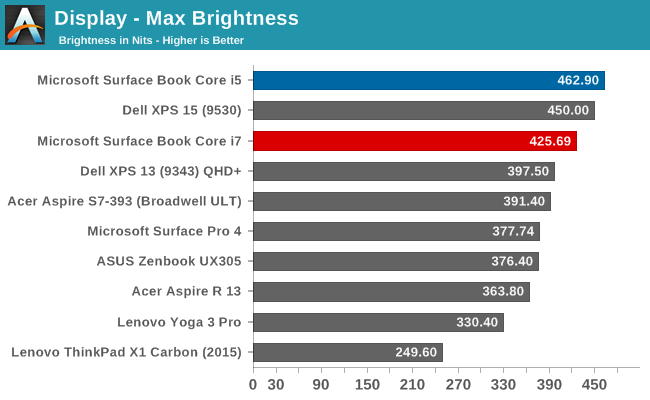
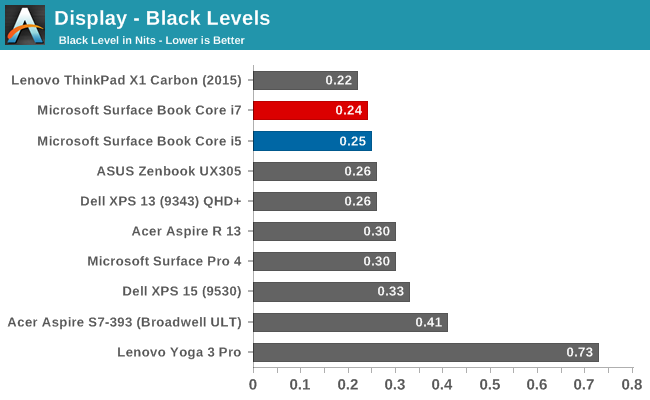
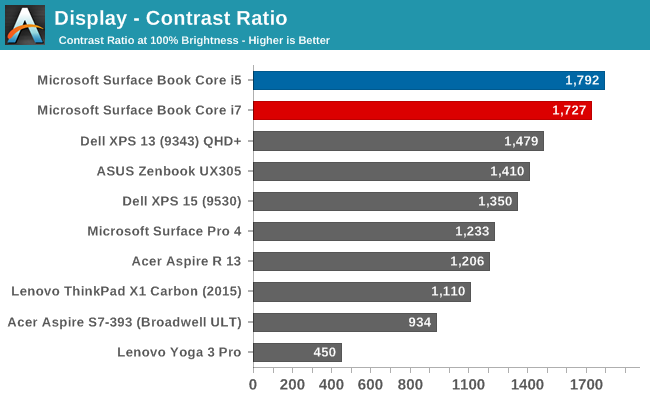
Our first test gets right to the heart of the claim from Microsoft, and sure enough, the Panasonic panel is able to deliver over 1700:1 on contrast. The best part is that the panel has achieved this with amazing black levels, and watching movies on the Surface Book really brings out a lot more detail in dark scenes than most devices are capable of. The brightness is also very good. The Core i5 model that I have has 462 nits of brightness and almost 1800:1 contrast, edging out the Core i7 sample.
Grayscale
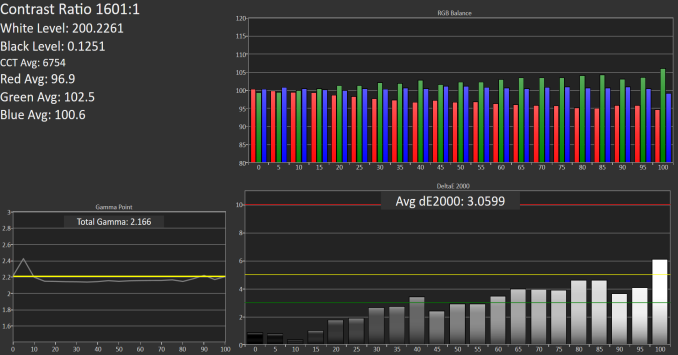 Core i5 Grayscale
Core i5 Grayscale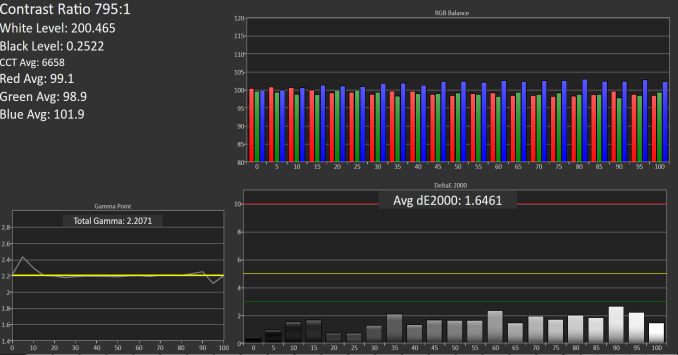 Core i7 Grayscale
Core i7 Grayscale
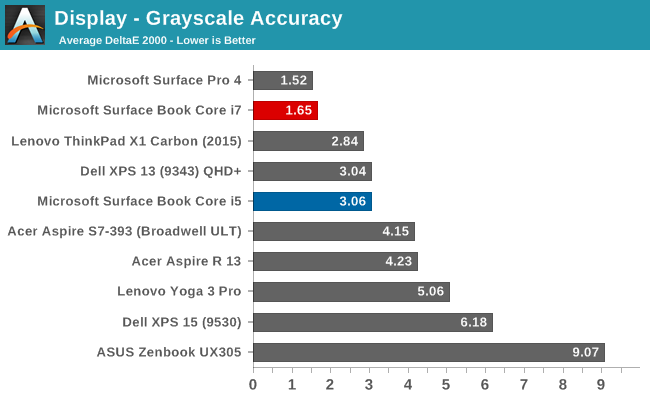
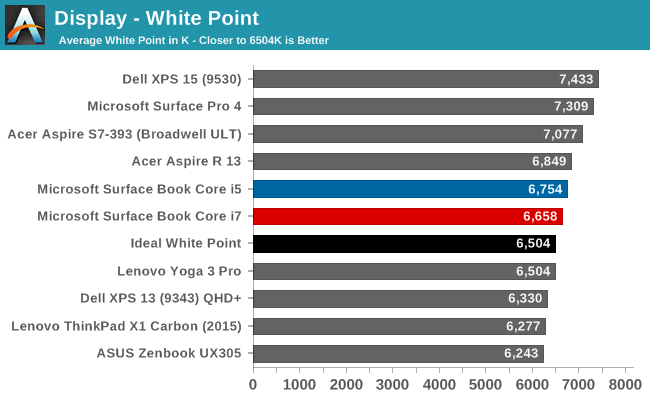
Both models do ok in this test, but the Core i5 model, which was a pre-production sample, had some issues with grayscale, especially as the brightness went up. The Core i7 model, which is a retail sample, seems to be much better here, but with just a sample size of two, it’s difficult to say if this is just luck of the draw. Color temperatures are very close to where they should be as well, and both keep gamma in check which is nice to see.
Saturation
Core i5 (left) Core i7 (right)

Once again, the Core i7 model outperforms the Core i5 pre-production model here, and by quite a bit, although both are well under the limit where you would be able to detect an issue. Both devices can pretty much cover 100% of the sRGB color space.
Gretag Macbeth
Core i5 (left) Core i7 (right)
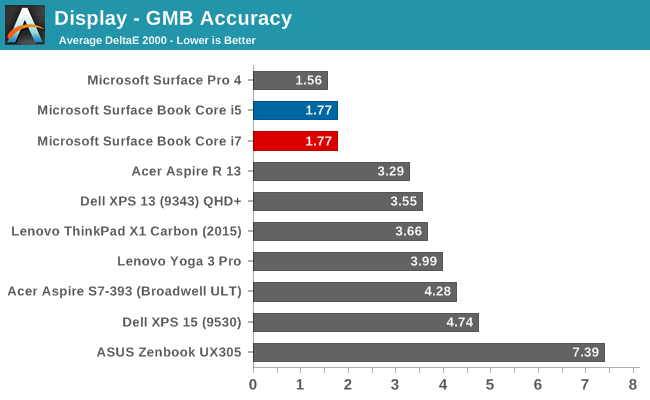
The most comprehensive test is the Gretag Macbeth, which tests not only the standard sweeps, but also many of the colors in-between, including skin tones. Both models do very well here, with pretty much none of the individual results scoring over 3.0.
Color Comparator
Looking at what all of this means, we can leverage these color comparators, which show the display’s intended color on the bottom, and the actual result on the top. This is a relative comparison, because any inaccuracies in your own display would skew the results.
Core i5 Color Comparator
Core i7 Color Comparator
Both models show very accurate colors, with little differentiation between the top and bottom parts of the images.
Microsoft has promised 100% sRGB coverage as well as individually calibrated panels, and it looks like they have done very well. The Core i7 model in particular, which is a retail sample, has no issues at all with the display accuracy. It’s interesting that they did not go with IGZO technology with the Surface Book like they did with the Surface Pro 4, but the Panasonic panel has amazing contrast, and the backlighting provides great brightness despite the amorphous silicon TFT. The black levels are very good on this display, and accuracy is certainly good enough for almost anyone’s needs. The high accuracy, combined with the high resolution, make the Surface Book one of the nicest displays around, and it’s a pleasure to use.
The days of high DPI being a real issue on Windows is slowly fading away, although there are still plenty of programs that do not play well. It really depends on what exact programs you have, but for most of my workflow high DPI is not a problem at all. Adobe has updated their apps to support higher resolution panels, for example. I’ve been using high DPI Windows PCs for several years now, and although there are still some apps that fall back to DPI virtualization, it’s not been an issue most of the time. If the Universal Windows App platform takes off, this will be well and truly solved, but that has not happened quite yet.


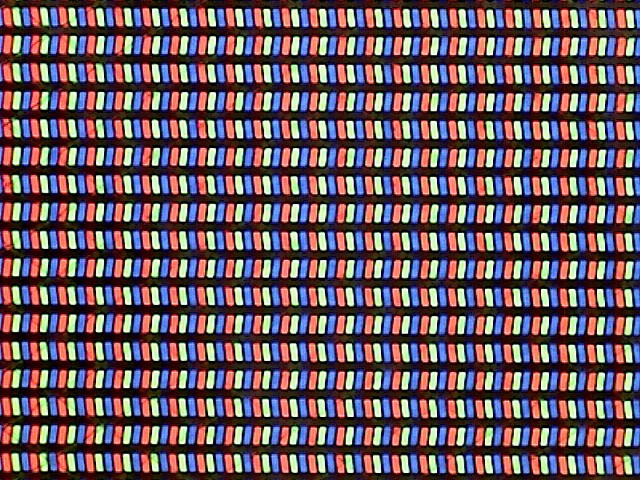
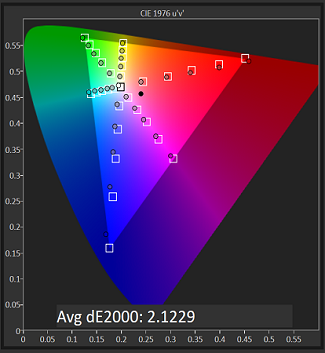
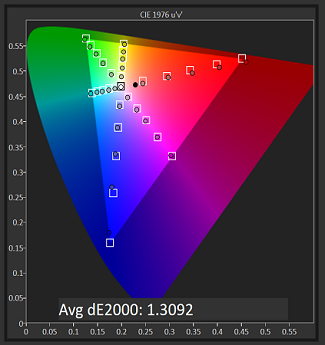

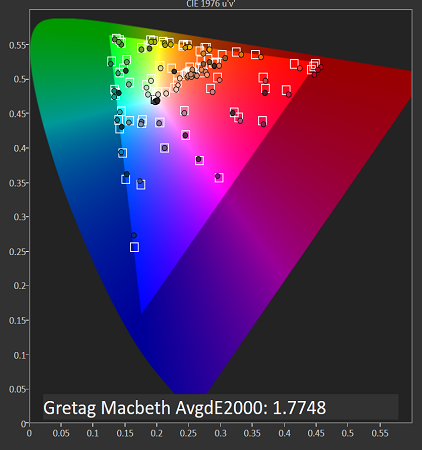












249 Comments
View All Comments
s.yu - Sunday, November 15, 2015 - link
Many ultrabook displays cover the same color gamut with just as good color and greyscale Delta E They're calibrated, they just don't advertise it so much. You're fooled by MS. As for 13.5" 3:2, 14" 16:9 is similar and you could get more done on the new XPS15's 15.6" screen, with more screen and less bezel.450nits, yeah that's unique, however quite useless. It's like Xperia Z4's ~800nits panel, nobody needs that much and sunlight visibility ends up slightly worse than S6's panel which topped at ~600nits. I just got a new panel for my notebook because the old one leaked liquid crystal. It's much brighter and sometimes seemed too vibrant (I admit it's 95% AdobeRGB) when displaying some saturated colors, which reminded me how much the old one's backlight aged in 3 years, but when I calibrated it, Spyder showed that it was only 194nits, I couldn't believe it as I was almost sure it's over 250nits just looking at it with my bare eyes, so I'm positive that I'll never need anything past 250nits on a notebook.
The narrow gamut on the MSB however, couldn't be made up for.
ninjacut - Tuesday, November 10, 2015 - link
After coming from Dell, Lenovo, HP I always wanted Microsoft to build their own laptop. So the Surface Book announcement was very exciting.The good technical part was covered well by Anandtech, with some gaps around pen, etc. with some obvious Apple bias creeping. But I don't agree with the conclusion. After the Nov 2 update, I have no issues with the unit. On the contrary, having used the device last 2 weeks made me realize how productive this device is.
I am impressed with the keyboard, touchpad, pen very superior to any earlier experience. The display is awesome in size and richness. Biggest surprise was how light is the display unit in tablet mode, hard to realize it has a Core i7 running with 8GB and 256 SSD.
In one of my recent meetings, I just removed the display and handed over to the client to go through some dashboards and he was flabbergasted. The meeting turned out very positive.
This unit is a keeper, and if the updates come in regularly I never will buy any other OEM laptop for sure
Cobalt Wraith - Tuesday, November 10, 2015 - link
Dito, in the same book and have not encountered any of the allegedly prevalent problems.s.yu - Wednesday, November 11, 2015 - link
Go on Amazon to read the amazing number of 1 star reviews. Some complained a great deal but gave 3-4 stars out of decency.solipsism - Tuesday, November 10, 2015 - link
1) I'm glad to see that the trackpad feel and firmware is decent.2) I don't know if it comes to down to a lack of volume or a lack of expertise, but MS's horrible use of space on their logic boards repeatedly wastes a shitload of space that could reduce the device volume, reduce the weight, and/or allow for a larger battery.
nikon133 - Tuesday, November 10, 2015 - link
Leaving space for next gen improvements? :)nerd1 - Tuesday, November 10, 2015 - link
Returning mine soon. May get thinkpad 460 instead.Teknobug - Tuesday, November 10, 2015 - link
Got my eye on HP Spectre x360 or Dell 13 7000, but saw the Yoga 3 Pro too.nerd1 - Tuesday, November 10, 2015 - link
x360 is a really nice device. Good build, nice screen (even 1080p), good keyboard and big battery. I don't like the weird trackpad (still usable though) and garbage synaptics pen though.It will be great if HP release a new x360 with 3:2 screen and wacom AES pen. I'd gladly pay $1500 if they make one.
GeorgeH - Tuesday, November 10, 2015 - link
I'm going to be "that guy".1) Not putting any information about the competing laptops (esp. CPU) makes the performance comparisons almost completely worthless, especially when you consider how sensitive U-series CPUs can be to their thermal solution and firmware configuration. I could of course assume that they are specced as tested in previous AT reviews, but why should I be doing that work?
2) A “bunch of battery” doesn't just disappear (conclusions). Either the battery life indication is bad or you’re not properly conducting/controlling the test. The fact that the Book’s fans became audible and very hot when closed makes me guess that Windows detected an idle state and was doing background tasks. That further tells me that the tests probably weren’t properly controlled and have significant margins of error.
3) I understand you no longer have review models in house, but there’s absolutely no mention of different Windows versions (or CPU/hardware differences) in your battery life tests (I know Win8/10 are almost identical, but still). Could the Book’s superior life be due to Windows 10, OS optimization work Microsoft did specifically for the Book, generational CPU improvements, or something else? Any of those could have been addressed and/or tested for, but instead we get an insipid “dunno, GDDR5?” statement. When we consider the fact that the GPU is undockable and that this device is therefore uniquely capable of a rough analysis of how adding a discrete GPU affects laptop battery life, that kind of “hell if I know” statement is even more ludicrous.
This was an OK review when compared to the raft of “long forum post” reviews available elsewhere, but very disappointing in relation to what I expect from an AT review.